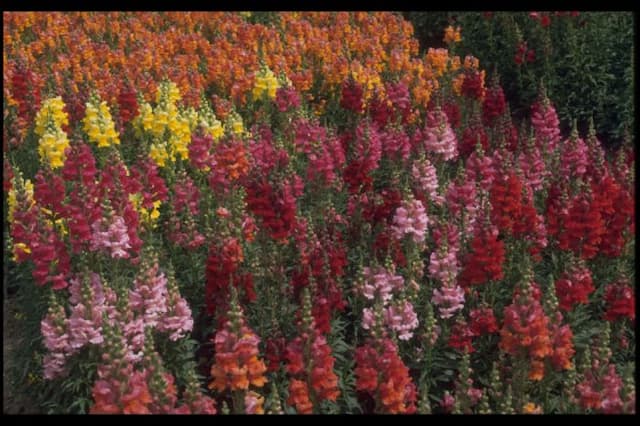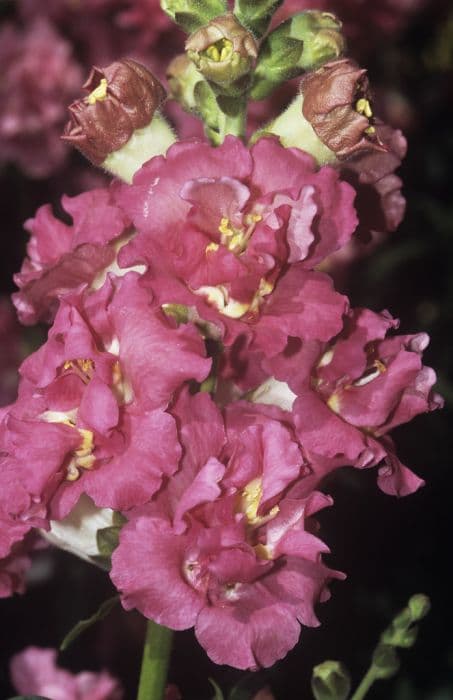Green Flowered Foxglove Digitalis viridiflora

ABOUT
Digitalis viridiflora, more commonly known as the green-flowered foxglove, is a visually striking plant. It is characterized by its unique spike of flowers that elegantly bell-shaped and hang downward. The flowers themselves are a subtle green hue, a color that is quite uncommon among the foxglove species, giving this plant a distinctive appearance in the garden. The foliage of the green-flowered foxglove forms a rosette at the base with leaves that are simple, lance-shaped and have a slightly furry texture which gives them a soft appearance. The leaves are a rich green color, which complements the unusual shade of the blossoms. The plant's overall structure presents a striking contrast with its soft textures against the firm, erect flower spike that emerges from the foliage. While exhibiting a more understated color palette, the green-flowered foxglove draws interest with its architecture and the uncommon color of its blossoms. It is often appreciated by gardeners and landscape designers looking for a plant that offers both textural variety and a different visual angle within plant arrangements.
About this plant
 Names
NamesFamily
Plantaginaceae
Synonyms
Green Foxglove, Green Flowered Foxglove
Common names
Digitalis viridiflora.
 Toxicity
ToxicityTo humans
Digitalis viridiflora, commonly known as the Green Flower Foxglove, is a plant that contains cardiac glycosides, which are compounds that can affect the heart. All parts of the plant are considered toxic if ingested. The toxicity can vary based on the amount consumed, but even small doses may cause significant poisoning. Symptoms of foxglove poisoning can include nausea, vomiting, diarrhea, headaches, abdominal pain, dizziness, confusion, weakness, changes in vision, and heart problems such as irregular heart rhythms, which can be life-threatening. Accidental ingestion requires immediate medical attention, as treatment may involve activated charcoal, medications, and supportive care to manage the effects on the cardiovascular system.
To pets
Digitalis viridiflora, commonly known as the Green Flower Foxglove, is also toxic to pets, including cats, dogs, and horses. Similar to humans, all parts of the plant contain cardiac glycosides. If a pet ingests foxglove, it can result in a range of symptoms due to the heart-affecting toxins. Symptoms in pets may include vomiting, diarrhea, drooling, abdominal pain, weakness, lethargy, dilated pupils, tremors, seizures, and potentially fatal cardiac abnormalities such as arrhythmias. If you suspect your pet has ingested any part of a foxglove plant, it is crucial to seek veterinary care immediately, as this situation can be an emergency requiring prompt treatment to address the cardiac effects and detoxify the animal.
 Characteristics
CharacteristicsLife cycle
Perennials
Foliage type
Deciduous
Color of leaves
Green
Flower color
Yellow-green
Height
2 feet [60 cm]
Spread
1 foot [30 cm]
Plant type
Herb
Hardiness zones
5
Native area
Europe
Benefits
 General Benefits
General Benefits- Attracts Pollinators: Digitalis viridiflora produces flowers that attract bees, butterflies, and other pollinating insects, supporting local ecosystems.
- Garden Aesthetics: The plant adds visual interest to gardens with its tall spikes of tubular flowers and can serve as a focal point or backdrop in a border.
- Wildlife Habitat: It can provide shelter and food for small wildlife, contributing to biodiversity.
- Drought Resistance: Once established, it is relatively drought-tolerant, making it suitable for gardens in drier climates.
- Low Maintenance: Digitalis viridiflora requires minimal care apart from occasional watering and deadheading, making it an easy plant to grow for gardeners of all levels.
 Medical Properties
Medical Properties- Cardiac glycosides: Digitalis viridiflora contains cardiac glycosides which are known for their use in treating certain heart conditions by affecting the force and efficiency of heart contractions.
- Heart failure treatment: The active compounds in Digitalis viridiflora can be used in medication for heart failure by improving the strength of the heart muscle contractions, leading to better blood circulation.
- Arrhythmia: It is used to correct certain types of heart arrhythmias due to its ability to regulate heart rate.
 Air-purifying Qualities
Air-purifying QualitiesThis plant is not specifically known for air purifying qualities.
 Other Uses
Other Uses- Dye Production: Digitalis viridiflora leaves can be used to extract a greenish dye, suitable for coloring fabric and other materials.
- Garden Design: With its tall spikes of greenish flowers, Digitalis viridiflora is prized for adding vertical interest and a unique color palette to cottage gardens.
- Hummingbird Attraction: The tubular flowers of Digitalis viridiflora are known to attract hummingbirds, making them an ideal choice for bird-friendly landscapes.
- Bee Garden Component: This plant is a valuable source of nectar for bees, and including it in gardens supports local pollinator populations.
- Photography Prop: Digitalis viridiflora, due to its unusual green flowers, is often used by photographers to create captivating images with a natural flair.
- Education and Research: Botanical studies often include Digitalis viridiflora for the purpose of understanding ecological relationships and plant morphology.
- Erosion Control: The robust root system of Digitalis viridiflora makes it useful for stabilizing soil in areas prone to erosion.
- Floral Arrangements: Fresh or dried, the unique blooms of Digitalis viridiflora can provide an unusual touch to floral arrangements and bouquets.
- Traditional Celebrations: In some cultures, the flowers of Digitalis viridiflora may be used in festivals or ceremonies as symbols of nature's beauty.
- Insect Habitat: The dense foliage and flower structures provide shelter for beneficial garden insects, enhancing biodiversity.
Interesting Facts
 Feng Shui
Feng ShuiThe plant Foxglove is not used in Feng Shui practice.
 Zodiac Sign Compitability
Zodiac Sign CompitabilityThe plant Foxglove is not used in astrology practice.
 Plant Symbolism
Plant Symbolism- Healing: Digitalis viridiflora, commonly known as Green-flowered Foxglove, contains digoxin, a compound used in heart medications, symbolizing its strong association with healing and medicine.
- Caution: Despite its medicinal properties, Green-flowered Foxglove is toxic, representing the duality of nature and the need for caution when handling it.
- Illusion: The beautiful, bell-shaped flowers may attract individuals, but the plant's toxicity means that it is not as benevolent as it appears, symbolizing the concept that not everything is as it seems.
- Pride: The tall, upright stance of the Green-flowered Foxglove can be seen as a visual metaphor for pride or confidence.
 Water
WaterGreen foxglove (Digitalis viridiflora) should be watered regularly, especially during its growing season in spring and summer, allowing the soil to dry out slightly between waterings. Typically, this means watering about once per week, but this can vary with temperature and humidity levels. The best method is to water deeply, so water reaches the root zone; for an average-sized plant, this might mean using approximately 1 gallon of water for outdoor plants, depending on weather conditions. During the winter, reduce watering to every few weeks as the plant's growth slows down.
 Light
LightGreen foxglove thrives in partial shade to full sun. The best spot is one where the plant receives morning sunlight and is protected from the intense heat of the afternoon sun. However, it can tolerate a variety of light conditions as long as it is not in full, intense sun, making it versatile for different garden spots.
 Temperature
TemperatureGreen foxglove prefers temperate climates with temperatures ranging approximately from 40 to 80 degrees Fahrenheit. It can survive minimum temperatures down to around 30 degrees Fahrenheit but should be protected from hard freezes. Ideally, maintain an environment where temperatures do not exceed mid-80s during the peak of summer for optimal growth conditions.
 Pruning
PruningPruning of the green foxglove is generally done to remove dead or faded flowers, which encourages further blooming and prevents the plant from self-seeding excessively. Ideally, prune immediately after the blooming phase, which is typically in late summer. Pruning can be done annually or as needed to maintain the plant's shape and vigor.
 Cleaning
CleaningAs needed
 Soil
SoilGreen Foxglove prefers well-drained soil rich in organic matter with a slightly acidic to neutral pH of about 5.5 to 7.0. The best soil mix for Green Foxglove should be loamy and have good drainage to prevent waterlogging, which can cause root rot. Incorporate compost or well-rotted manure into the soil to improve fertility and structure.
 Repotting
RepottingGreen Foxglove typically does not require frequent repotting, as it is a biennial plant. Repotting can be done every 2 to 3 years, or when the plant becomes root-bound, although it's often treated as an annual or grown from seed every year.
 Humidity & Misting
Humidity & MistingGreen Foxglove thrives in moderate humidity levels but is relatively adaptable to a variety of conditions. Aim for about 40-60% relative humidity for this plant but ensure good air circulation to prevent diseases especially if grown in a greenhouse or indoor environment.
 Suitable locations
Suitable locationsIndoor
Provide bright, indirect light and cool temperatures inside.
Outdoor
Full sun to partial shade in cool, moist conditions outdoors.
Hardiness zone
4-8 USDA
 Life cycle
Life cycleDigitalis viridiflora, commonly known as the Green-flowered Foxglove, begins its life as a seed, which germinates in moist, well-drained soil in partial to full sun exposure. Upon germination, the seedling develops into a rosette of leaves at the soil surface, which is a vegetative stage of growth where the plant accumulates energy. In its next phase, usually in the second year, the plant sends up a tall flower spike adorned with tubular, greenish-yellow flowers which are pollinated by bees, leading to the development of seed capsules. After pollination and throughout the summer, these capsules ripen, eventually splitting open to release numerous small seeds. The parent plant may die after seed production if it is a biennial, completing its life cycle, or it may continue to grow and produce flowers in subsequent years if it has perennial tendencies. These seeds, once dispersed, have the potential to establish new plants, continuing the cycle of growth for the species.
 Propogation
PropogationPropogation time
Spring to early summer
For Digitalis viridiflora, commonly known as Green Foxglove, seed sowing is the most popular method of propagation. The ideal time to sow seeds is late spring to early summer, following the last frost when the soil has warmed. The seeds are sown directly into well-draining soil in a shaded or semi-shaded area. They should be lightly covered with soil, as they need some light to germinate effectively. It usually takes around 2 to 4 weeks for the seeds to germinate at a temperature of about 65 to 70 degrees Fahrenheit (18-21 degrees Celsius). Thinning should be done once seedlings are large enough to handle, spacing them around 12 to 15 inches (30-38 centimeters) apart to allow for mature growth. Regular watering should be maintained to keep the soil moist but not waterlogged, ensuring a successful propagation.





![Snapdragon [Pretty in Pink]](/_next/image?url=https%3A%2F%2Fplants-admin.emdemapps.com%2Fimages%2Fplants%2F%2Fimages%2F604b5cb3b5385.png&w=640&q=75)



